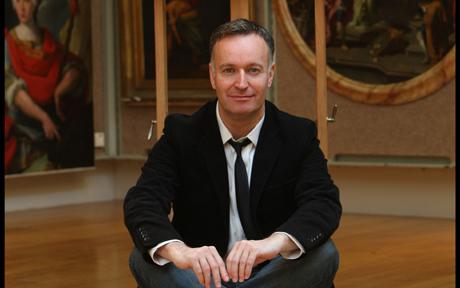Andrew O’Hagan appeared on The Bat Segundo Show #372. He is most recently the author of The Life and Opinions of Maf the Dog, and of His Friend Marilyn Monroe.
Listen: Play in new window | Download
Condition of Mr. Segundo: Feeling sartorially inadequate and unwilling to beg for his dinner from the table.
Author: Andrew O’Hagan
Subjects Discussed: [List forthcoming]
EXCERPT FROM SHOW:
Correspondent: It is interesting. You want to have the dog smarter than everybody else in the book. And this leads me to ask you about the footnotes in this. I mean, from a formalistic standpoint, well, we view dogs at our feet. And the footnotes, of course, reflect that particular —
O’Hagan: And the dog’s always going to love footnotes because they can identify the position.
Correspondent: Exactly. But initially many of these footnotes are there to clarify little cultural tidbits. Almost gossip. Like: What is Douglas Sirk’s real name? But as we read the footnotes more, they then become very concerned with clarifying specific facts. Almost in a hectoring tone towards the reader. I’m curious about how the footnotes came to be from just this tonal shift that goes throughout the book, and also if you were tempted to allow the footnotes to go maybe further than eight lines at some point. What did you do to keep that down?
O’Hagan: Well, it’s interesting that. If I had my own way, if I lived in a world of pure O’Haganism, then the footnotes would have gone on for volumes and have a Shandy-ian or Borgesian nightmare where the footnotes were longer than the book. I like the comic potential with that sort of thing. And I like the idea that this was a work of bricolage, as the French would say. That it was an attempt to build up phenomenon in the reader’s mind. Which could increase their confidence about what consciousness was. Cause after all, this was really a book about inventing the notion of consciousness for an animal. I built it up from the ground up. And he does say early in that process of life for him — quite early in the book when he’s still in England — he says, “Dogs love digression.” So it made it natural to me that at some point he would start to deploy the footnote. Which is nothing if not a little contained digressionette. I liked the idea that he would occasionally stop the narrative in order to point something out to the reader. To wag a finger or a paw and give a notion of other worlds of knowledge which might be available. Maybe while pointing towards. He’s a friendly little scholar as much as anything else. He’s a pedant too. And all these things are exciting character traits of his to me. So I had to make him stay in character. And it would be in his character to offer footnotes. Even ones that were hectoring or were strictly unnecessary. They add to the entertainment value overall, I feel.
Correspondent: But to go back to what we were discussing earlier about the comedy vs. the tragedy, and how this reflects human life, early on in the book Maf says in one of these footnotes, “Unlike humans, we can hear what people are saying from themselves. And we can sniff illusion.” Later you have Maf finding “the real difference between humans is that some care about authenticity and some don’t care at all.” Why must the humans in this book be so tied or interconnected with authenticity and illusion?
O’Hagan: Because I think it’s an utterly 20th century obsession. The mid-20th century obsession particularly. Hollywood having held such a position in cultural life the world over. American moviemaking created a sensibility in the 20th century. It didn’t just reflect sensibilities. It actually created a mind set. A notion of natural human behavior and democracy, which I often think was illusory too. But then it was very attractive to the world. Very viable. And I knew that this dog was going to be having its life at the center of that. So I wanted these questions — illusion and reality, illusion dipping into delusion, our condition of being overwhelmed by fakery almost — to be something that the dog had an inside view on. An inside view for a number of reasons: (1) Which is that he’s a novelist at heart. And novelists really know what illusion is all about. We are a conjuring artist as a novelist. You’re playing god with lives and experiences and parts of history and vocality and patterns of speech. You know, you are a trickster. And I think that I’ve always been interested in that fact. And I wanted this little avatar of mine. This little novelist manqué, of Maf the Dog, to be somebody who could look at not only the world of Hollywood and psychoanalysis and politics and the early 60s from an insider’s view — which Maf certainly had. The real dog was in all of those worlds with Marilyn at the time. She was a real figure who had very deep experience of illusion. And I wanted to manipulate that for the reader to present an opportunity to look at the relationship between reality and imagination in a fresh way.
The Bat Segundo Show #372: Andrew O’Hagan (Download MP3)
